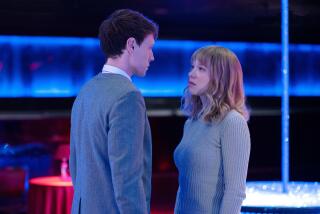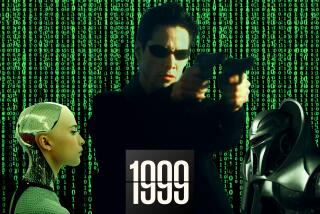New films like ‘Gravity,’ ‘Her’ connect the high-tech with the heart
Loneliness, hubris, depression and other fixtures of human frailty get amplified by technology in several of this year’s most forward-thinking films. In “Her,” “We Steal Secrets: The Story of WikiLeaks” and “Gravity,” direct person-to-person contact comes across as old-fashioned 20th century behavior. Instead, characters connect with each other through ear buds, smartphones, message boards, passwords, radio transmissions, encrypted files, uploads, downloads and computer screens. For motion pictures that cast modern technology as the Great Enabler, it’s all about the interface.
Spike Jonze’s “Her” imagines a near-future world in which Joaquin Phoenix’s lonely Los Angeles geek, Theodore, makes his living by dictating intimate letters to people he doesn’t know. Lacking connection in his own life, he installs, and soon falls in love with, a charming operating system named Samantha. Voiced by Scarlett Johansson, this artificial intelligence personal assistant, curious, funny and compassionate, makes most of the film’s flesh and blood characters seem churlish by comparison.
“Her” production designer K.K. Barrett, a longtime Jonze collaborator, says “I don’t think the film has a manifesto to comment about whether technology is good or bad. It’s more about love. People can fall in love with inmates in prison that they’ve never met, or you can fall in love with an operating system, or you can fall in love with a car. All those things are very real to the person who’s experiencing it.”
VIDEO: Highlights from the Envelope Screening Series
In place of clunky computer screens and shiny gadgets, Barrett kept Theodore’s connective devices as unobtrusive as possible. “The ear piece was under-designed,” he says. “‘How small can we make it and still make people be aware that it’s there in Theodore’s ear?’ And then when he picks it up and puts it in, then he’s connected with Samantha.”
As Theodore walks down the street, everybody he passes is glued to his or her smartphone, engaging with their own super-friendly operating systems. “That’s not a prediction,” notes Barrett. “It’s a reality.” Still, iPhone’s Siri has a lot of catching up to do before it matches Samantha. Barrett says, “There are moments where you go, ‘Oh, that’s a gorgeous sexy voice,’ like that’s his partner on the other end of the line. But it’s not his partner. It’s a constantly computing entity that’s growing faster than he is.”
Contrasted with “Her’s” generally cheerful portrait of technology’s potential as a world-class connector, Alex Gibney’s dark documentary “We Steal Secrets: The Story of WikiLeaks” (along with Bill Condon’s feature, “The Fifth Estate”) chronicles the disruptive impact of hacker Julian Assange’s pioneering Web repository for classified government information. Gibney, who won an Oscar for 2007’s “Taxi to the Dark Side” exposé of U.S. treatment of a foreign prisoner, admires the site’s founding principles. He says, “Those early leaks, the videos, were tremendously important as a historical fact.”
Replete with betrayal, guilt and idealism, the drama unfolds largely through message boards and emails rather than in-person confrontations. Whistle-blower Bradley Manning had never even met the trusted confidant who revealed his identity to the FBI.
Assange, who declined to appear on camera, used the very Internet-powered tools described in “We Steal Secrets” to critique the documentary after its release. Gibney says, “Recently Julian found out there was a class that was watching ‘We Steal Secrets’ and tweeting about it, so he made it a point to tweet to every member of that class. He’s tried to brand the film as being anti WikiLeaks, when in fact it’s terribly impressed with the fundamental principals.”
“Gravity” achieved narrative liftoff by articulating themes of technology, isolation and communications in epic terms. Jonás Cuarón, who co-wrote Sandra Bullock’s lost-in-space star turn with his father, director Alfonso Cuarón, notes that “Gravity’s” interstellar setting came fully loaded with high-tech metaphors. “As soon as we found out that NASA scientists actually referred to this tube that basically connects oxygen to the suits as ‘umbilical cords,’ we were immediately obsessed with it. In a story about rebirth, what better thing can you have than an umbilical cord?”
Encasing Bullock’s character Ryan in a space suit for much of the movie also served the narrative arc, he says. “We found space to be a great setting for Ryan in that she’s so detached from life that she literally lives inside her own bubble — the space suit. And then the taking off the suit — it’s as if she’s coming out of the bubble, shedding her old skin and starting this new journey into life.”
The man-made debris storm that precipitates “Gravity’s” central catastrophe implicitly raises questions about the dangers of high-tech communication overload, says Cuarón. Citing astrophysicist Donald J. Kessler’s warning about cosmically-scaled traffic accidents as inspiration, he says, “The Kessler Syndrome says we have such a high density of satellites and space junk in orbit floating at such high speed, that if two of them were to collide it would create a chain reaction. For us, that was an interesting concept: That all this technological prowess and development is going to end up biting us in the …”
More to Read
Only good movies
Get the Indie Focus newsletter, Mark Olsen's weekly guide to the world of cinema.
You may occasionally receive promotional content from the Los Angeles Times.






